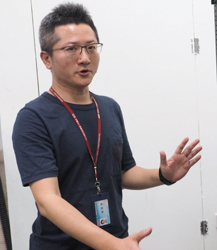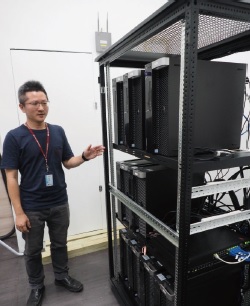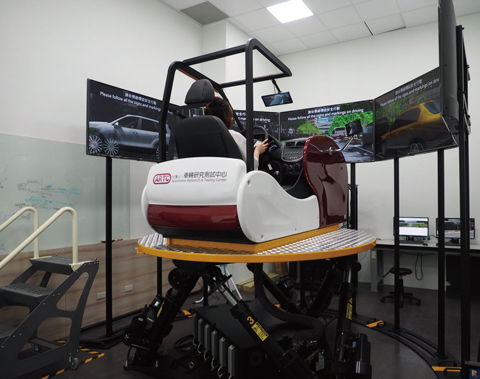 |
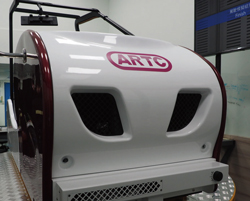 |
| The driving simulator with 6DOF motion plate that reproduces the displacement
and rotation in up, down, left, right, and back and forth. |
"ARTC has constructed simple virtual reality (VR) environments that
a steering and gas pedal are integrated, but it was hard to reproduce the
friction and bumps of road surface, and the vehicle behavior according
to acceleration and deceleration precisely. That's why we started to consider
FORUM8's driving simulator with 6DOF motion plate", explains Mr. Vector
Yeh, the director of the department of ARTC Mechatronics System.
Before introducing the driving simulator, images were static like shot
by a camera, and it was impossible to recreate changes and shaking of road
or the vibration that real vehicles produces according to speeding and
braking. However, these test results made from static images easily caused
unexpected troubles when it was used on a real vehicle.
|
The existing simulators had another problem. They could not test the Autonomous
Emergency Braking (AEB) to prevent from collision with obstructions in
front and the Adaptive Cruise Control (ACC) to keep a certain distance
from the vehicle driving in front.
Because of the long cooperation between ARTC and Cybernet Systems Taiwan
whose headquarter is located in Tokyo, ARTC started to use FORUM8's driving
simulator.
"We have collaborated with ARTC many times. For example, we delivered them a simulator for development called HILS (Hardware-In-the-Loop-Simulation) that can reproduce behaviors of real engine and vehicle", explains Mr. Mary Hsieh, the manager of Cybernet Systems Taiwan.
In 2016, Cybernet Systems Taiwan heard that ARTC was considering a new
vehicle simulator and positively gave it the information of FORUM8 solutions
including UC-win/Road and driving simulators. Cybernet Taiwan also joined
the hardware integration and communication interface development and helped
ARTC to introduce the driving simulator this time.
|
|
 |
Coverage staff's smartphones
To keep secrets, the camera lens is covered with
seal when the phones are brought in ARTC. |
|
Mr. Yeh says, "We chose the FORUM8 product from lots of driving simulators
because it can be customized flexibly with easy settings and has good sense
of reality. Other advantage was the smooth cooperation with hardware and
software of other companies such as 'CarSim', which is a vehicle motion
simulation software made by Virtual Mechanics Corporation, and a steering
device with the force feedback system that is made by SENSODRIVE and gives
a realistic driving feeling".
Cybernet Systems Taiwan has accumulated know-how by working on the automobile
industry in Taiwan. It was expected to help ARTC's research and test and
connect to good study result in the future.
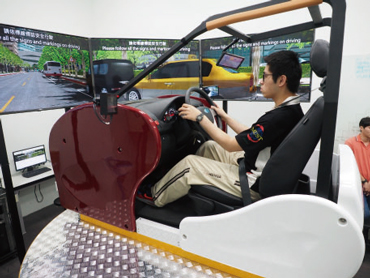 |
 |
A research member doing the test driving by using the driving
simulator reproducing the traffic situation in Taiwan. |
The 6DOF motion plate reproduces the vehicle's dynamic
characteristics precisely. |
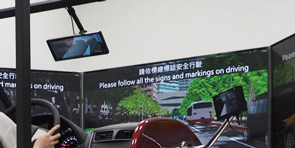 |
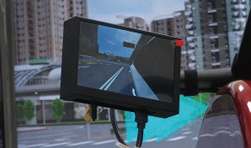 |
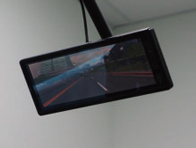 |
|
Images in door mirrors are also reproduced
in a small monitor. |
The rear mirror shows vehicles
behind. |
The usage purpose of driving simulator for now is to reproduce the dynamic
characteristics of vehicle and reproduce the relation between vehicle motion,
real-time sensor, and control unit. In the future, driving simulators will
be able to be used for the experience of autonomous driving and the test
of control algorithm.
The biggest benefit of this simulator brought by the 6DOF motion plate
is that it can be used for the simulation of autonomous vehicle in addition
to the basic driving education training. Users can try the comfort of vehicle
controlled by autonomous driving, and the degree of influence that the
vehicle dynamic feature gives to sensors can be considered.
|
UC-win/Road runs on a Windows computer and communicates with a driving
simulator controller via UDP (User Datagram Protocol) network communication
that is a sort of the internet protocol. The 6DOF simulation platform reproduces
the vehicle motion calculated by CarSim.
Traffic situations specific in Taiwan can be created in UC-win/Road. For
example, traffic scenes in Taiwan including traffic lights and signs can
be mapped easily.
UC-win/Road can depict traffic signs. For example, we created scenes based
on the Nangang Software Park in Taipei. The motion of vehicle is calculated
by using the CarSim software. This software precisely displays the response
of vehicle under various road conditions and reproduces the driving feeling
in a sense of realism through the driving simulator.
"I could reproduce the realistic driving feeling through dynamic results
of UC-win/Road screen rendering and CarSim motion platform. I think we
can use UC-win/Road to create realistic situation and reproduce driving
circumstances that the autonomous vehicle faces and the real traffic condition
in Taiwan", says Mr. Yeh.
|
|
|
As a future research, ARTC is planning to evaluate the comfort of vehicle
and vehicle reaction during the driving by vehicle control using autonomous
driving algorithm. It will be able to do the adjustment of autonomous driving
algorithm and parameter tuning. The reaction of the control unit can be
tested by connecting the autonomous driving control unit to the driving
simulator when testing HiL. Testing dangerous scenes in simulation can
decrease the risk compared to the test by using real vehicle.
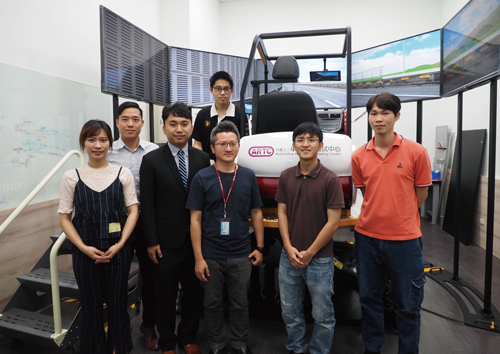 |
| Members who introduced the 6DOF driving simulator |
|
